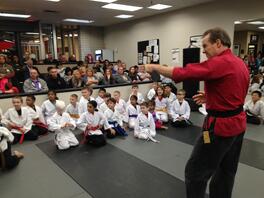Here are five steps to teach the best classes possible. I recommend reviewing these with your team, or whenever you feel your classes have had lower energy than usual.
 Step one: Before Class---Always have a plan. It is far too common for an instructor to step out onto the floor, bow in the students, and start the warm-up without having a clue as to what he or she is going to teach the class. The result is almost always an average class, at best. On the other hand, if you plan the class beforehand, your energy and enthusiasm will be very high because you’re excited about delivering your well planned material to your students! And that energy and enthusiasm is infectious. When you focus on your plan, your energy and enthusiasm is transferred to your students resulting in a great class where everyone is focused and energized.
Step one: Before Class---Always have a plan. It is far too common for an instructor to step out onto the floor, bow in the students, and start the warm-up without having a clue as to what he or she is going to teach the class. The result is almost always an average class, at best. On the other hand, if you plan the class beforehand, your energy and enthusiasm will be very high because you’re excited about delivering your well planned material to your students! And that energy and enthusiasm is infectious. When you focus on your plan, your energy and enthusiasm is transferred to your students resulting in a great class where everyone is focused and energized.
Step two: During Class---Have the right mental attitude. While it is important to prepare beforehand, it is also important to have the right mental attitude during class. It is absolutely critical to remember that the moment you step on the mat your entire focus and energy needs to be directed to your students. Your students rely on you for energy, focus and enthusiasm. They do not want to hear about your problems. Every action you take indicates that this is where you want to be; this is what you want to be doing. Reciting the instructors creed can help put you in the right mental state. “I will teach this class; as if it is the most important class I will ever teach. I am patient and enthusiastic. I will lead by example.”
Step three: Don’t let distractions change your focus.
Inevitably, in every class there will be some distractions: an overactive student, a new prospect standing impatiently next to the mat, unhappy parents, or some other situation. Whatever it is, don’t let it reduce the focus, energy and enthusiasm in the classroom. Going back to step one, preparing for such an event (having a staff member who can intercede) can reduce or eliminate the distraction. Keep a clear vision of what you intended for the class. Make whatever adjustments are necessary, and keep the class energized and focused.
Step four: Deviate when necessary.
Every now and then, something happens during class that forces you to change the direction of your class. In other words, there are exceptions to the rule specified in Step Three. Use good judgment and determine when it is appropriate to make an exception. It might be a minor emergency that calls one of your assistants off the floor, or it may be that you see some aspect of your student’s performance that needs extra work or, perhaps your class plan just isn’t going as you thought it would. In these instances, make exceptions and deviate, always remembering to keep the focus and energy of the students at their peak.
Step five: Track your progress
At the close of each day, make a note of how well your classes went. What drills worked? What drills didn’t? It is amazing how quickly a file of great class ideas and drills will build up. The more you track your progress, the easier planning for great classes becomes. There’s a great phrase that sums up the attitude you should have about teaching “Always be happy, but not satisfied." You should be happy with your skill level. Happy with your teaching skills. But you should never be fully satisfied with either. There is always room for improvement.
Using these Five Steps will help ensure that each and every class that you teach is focused and energized.
|
Martial Arts School Owners: Want to grow a successful martial arts school? Receive a free walkthrough of our resources and coaching, make an appointment... |



